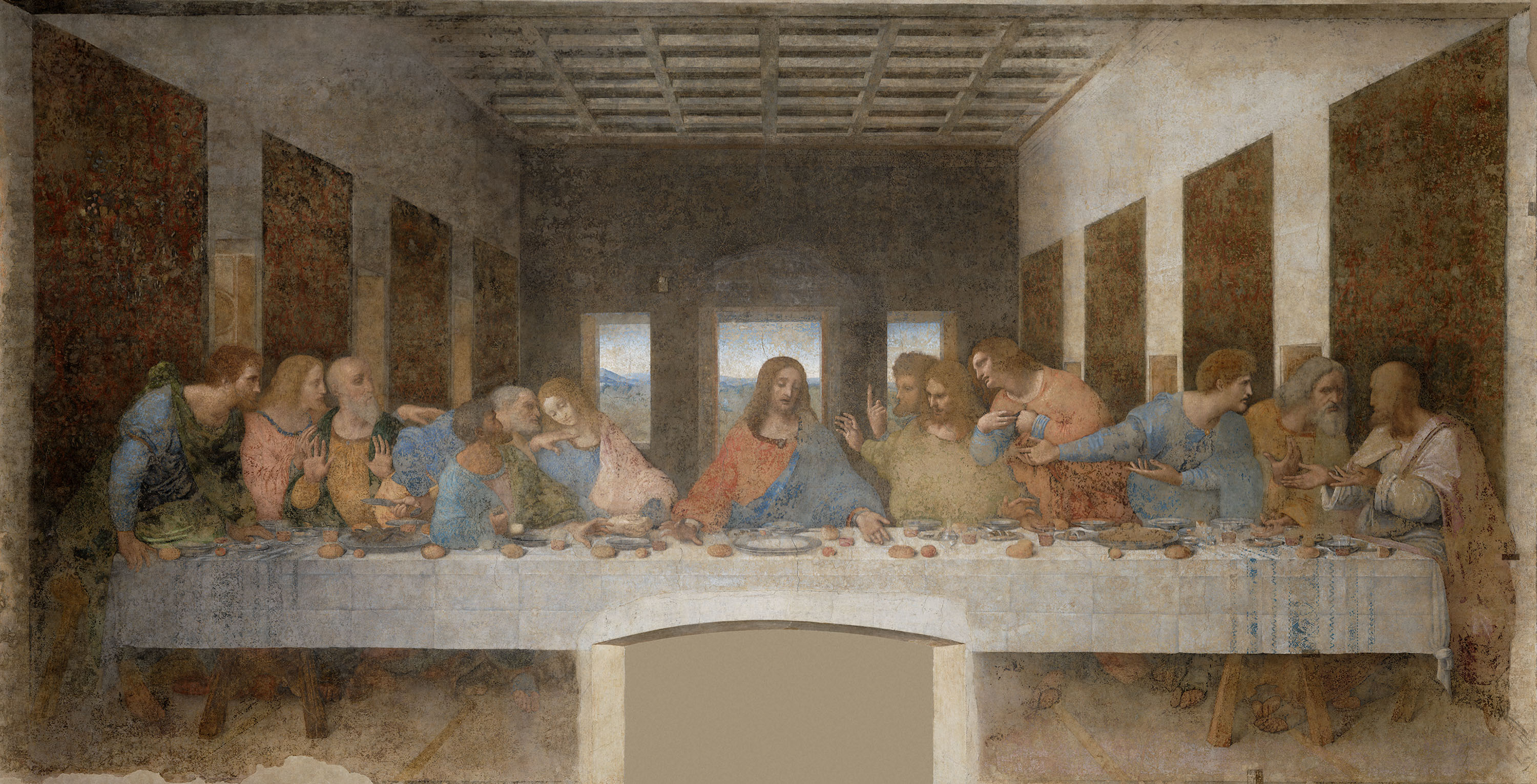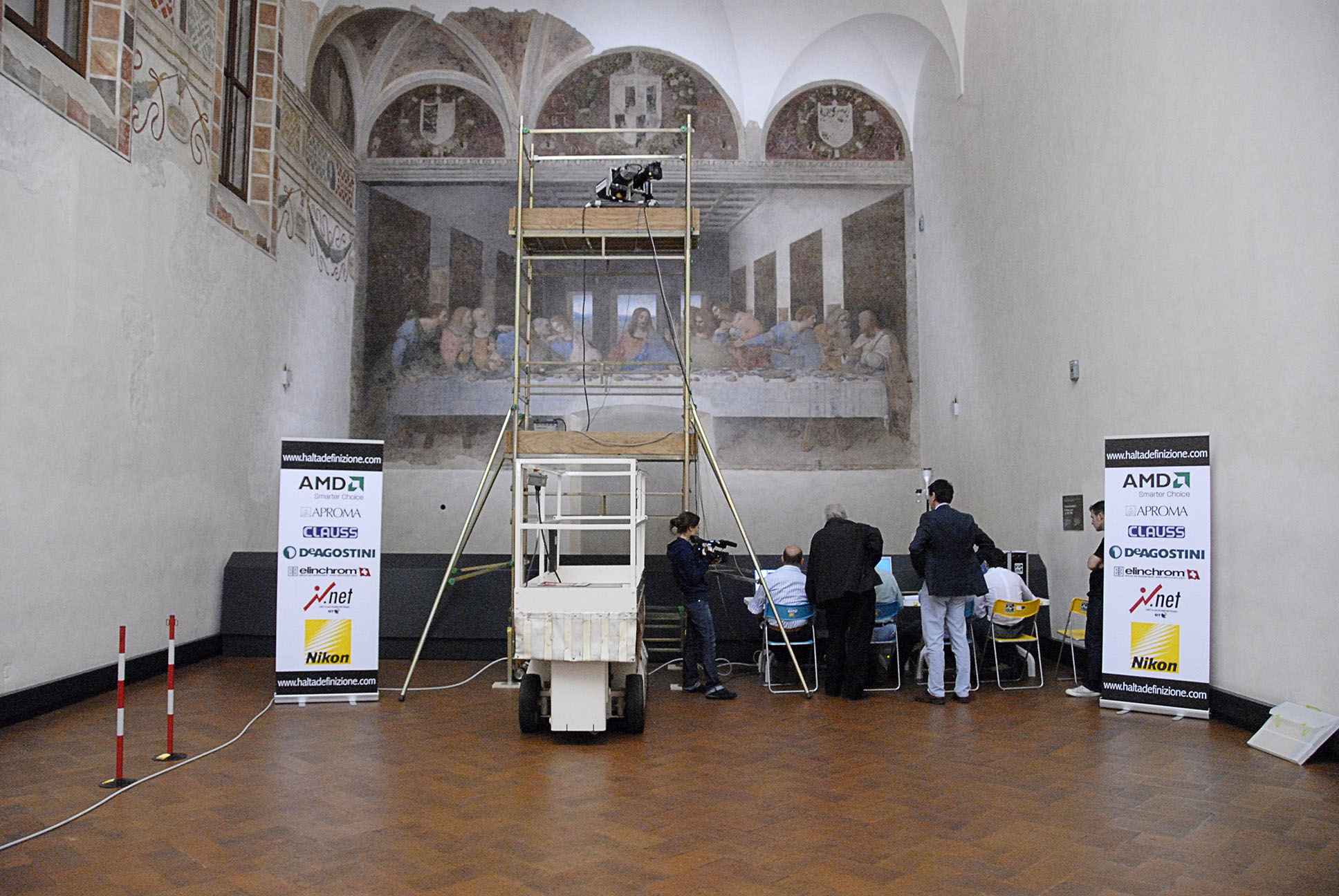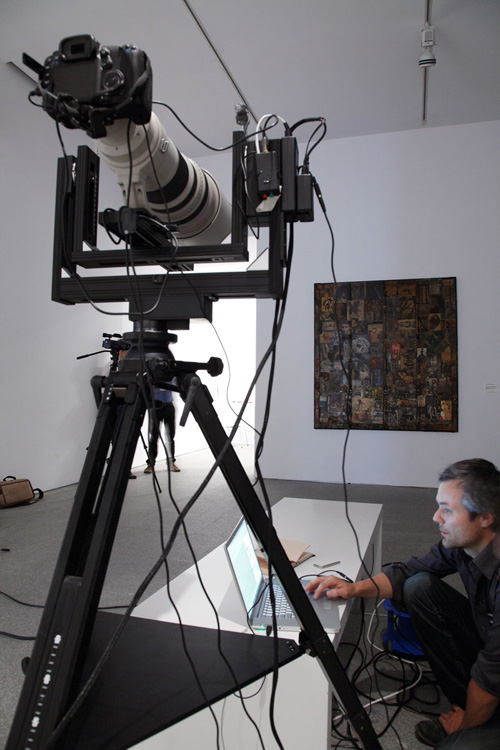
Digitisation of "L'Ultima Cena" (Leonardo da Vinci)
Milan, 27 October 2007 - For the first time in history, a painting is being reproduced and made available to the world public in such high resolution and detail that even the hole left by a pin in the fresco becomes visible. It took six months of intensive preparation and the support of partner companies, each of which is considered a market leader in its field, to scan Leonardo da Vinci's masterpiece with a massive resolution of no less than 16 gigapixels. What such a high resolution is needed for, what technical challenges the Haltadefinizione team had to overcome and how the technology has developed since then, you can read on the following pages.
"L'Ultima Cena" - "The Last Supper" shows the biblical story of the last meal of Jesus Christ and his 12 apostles on the evening before his arrest. In 1494, the world-famous Milanese painter and sculptor Leonardo da Vinci was commissioned by the then Duke Ludovico Maria Sforza to embellish a wall in the dining hall of the monastery "Santa Maria delle Grazie" with this very scene over a width of approx. 9 m. The scene was painted on the wall. When da Vinci finished his masterpiece 4 years later, an almost unbelievable odyssey of the painting began. Even Napoleon Bonaparte tried to seize it and had it removed from the wall for this purpose and brought to France. Later, during the Second World War, when it was already back on the wall in the monastery, it even survived the direct hit of an aerial bomb. It is almost a miracle that the work has survived to this day despite all the insane paths it has taken. It has been listed as a UNESCO World Heritage Site since 1980 and has also become part of popular culture, not least through its theming in books and films.

But time has left its mark, as can unfortunately be clearly seen. Despite comprehensive and meticulous restoration as well as monitored room climate control and careful restriction of UV exposure, the condition is increasingly deteriorating. For this reason, the decision was made in 2007 to carry out a high-resolution digitisation, unprecedented up to that time, in order to document the condition of the painting and thus preserve it for posterity, at least in digital form. Part of the plan was also to make the work available on the internet free of charge in full resolution in order to make it available internationally for research and teaching. The Italian company HAL9000 s.r.l. was commissioned with the implementation of the digitisation, which began its work under the project title "Haltadefinizione" and initially clarified the technical possibilities.The use of a conventional repro camera with a scan back was rejected at an early stage, as the quality to be expected, particularly with regard to the resolution, was too low by a factor of 20 to 100 and was thus classified as insufficient. In addition, the painting, with its dimensions of approx. 9 m wide and 4 m high, posed a particular challenge. The large image area posed further problems. For example, artificial lighting that was as homogeneous as possible was necessary for a natural colour rendering, albeit with constraints. The total exposure, especially to light in the hard UV spectrum, had to be reduced to a minimum to avoid consequential damage from digitisation. All in all, it was a difficult undertaking, which is why the Haltadefinizione team decided to call in CLAUSS as the world's leading specialist for gigapixel photography as a project partner.

The German-based company, founded in the early 1990s, specialises in the development of opto-mechatronic high-end recording systems. Adapted to the special challenges, CLAUSS developed a recording system especially for art reproduction, which was used for the first time as a prototype for "L'Ultima Cena" in 2007. The painting is not photographed with a single shot, but with a large number of individual images.

Each individual image shows only a tiny section of the painting, but with a physically high spatial resolution. The location of the image remains unchanged, which is particularly important for uneven surfaces. The optics, a high-quality photographic telephoto lens with a focal length of 600 mm, were supplied by the traditional Japanese company Nikon. The camera used was the D2x model from the same manufacturer with a resolution of 4 288 × 2 848 pixels. Due to the different distances between the camera and the centre of the image compared to the edges and corners, different resolutions result over the image area. The maximum resolution is achieved in the centre of the image with approx. 450 dpi. At the corners of the image, however, the resolution drops to approx. 300 dpi.

By splitting the entire painting into many small partial shots, the lighting problem could also be solved. Instead of having to illuminate everything and expose the painting to an unacceptably high dose of light, especially harmful UV radiation, it was now only necessary to illuminate the part of the picture that was in focus, and only for the brief moment of the shot. In order to ensure the lowest possible noise and true-colour digitisation, it was decided to use a high-performance flash head from the manufacturer Elinchrom, which was additionally equipped with special filters to minimise UV output and a pinhole to limit the illuminated area. A total of 1,677 positions were automatically approached and one image taken each time. Afterwards, an overall image was digitally calculated from these many individual images. In order to avoid transitions between the partial images in this calculation, a certain amount of overlap is required between the partial images. Thus, a total of about 20 gigapixels were captured, but the final result comprises only about 16 gigapixels (172 181 × 93 611 px). The image data was transferred directly to a PC via USB cable and checked, as a repetition of the recording would only have been possible with considerable additional costs and a longer waiting time.The camera was moved and controlled by the recording robot RODEON piXposer. The extremely high precision and stability combined with a high payload are the special features of this system and make such a composite recording possible in the first place. Since 2007, the pick-up system has been built in series and subjected to numerous detail improvements. A multitude of accessories developed over the years makes it possible to universally adapt the large-format scanner to almost any imaging session. Even reflective surfaces such as gold inlays can be imaged with the help of special lighting. The RODEON piXposer is still the only system worldwide that allows the reproduction of large images without compromising on quality. At the same time, the piXposer is highly appreciated for its portability, reliability and flexibility. Thus, the system grows with the evolving camera technology for DSLRs and photo lenses. Only a few weeks after the "Last Supper" was digitised, it was published online and can be viewed in original size at www.haltadefinizione.com. There you can also find a second photograph taken in 2009, which documents the changes made to the painting over time. A third photograph is already being planned and is to be realised in the first months of 2020.

CLAUSS' technique of capturing a painting in many small partial images and only then stitching them together has now become established. For example, several hundred outstanding works of art worldwide, including the "Mona Lisa" (Louvre, Paris) or the "Babylonian Procession" (Pergamon Museum, Berlin) have been digitised as part of the "Google Art Project" with the help of RODEON piXposer systems.
